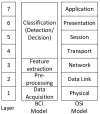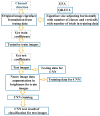A Novel Quick-Response Eigenface Analysis Scheme for Brain-Computer Interfaces
- PMID: 35957420
- PMCID: PMC9370919
- DOI: 10.3390/s22155860
A Novel Quick-Response Eigenface Analysis Scheme for Brain-Computer Interfaces
Abstract
The brain-computer interface (BCI) is used to understand brain activities and external bodies with the help of the motor imagery (MI). As of today, the classification results for EEG 4 class BCI competition dataset have been improved to provide better classification accuracy of the brain computer interface systems (BCIs). Based on this observation, a novel quick-response eigenface analysis (QR-EFA) scheme for motor imagery is proposed to improve the classification accuracy for BCIs. Thus, we considered BCI signals in standardized and sharable quick response (QR) image domain; then, we systematically combined EFA and a convolution neural network (CNN) to classify the neuro images. To overcome a non-stationary BCI dataset available and non-ergodic characteristics, we utilized an effective neuro data augmentation in the training phase. For the ultimate improvements in classification performance, QR-EFA maximizes the similarities existing in the domain-, trial-, and subject-wise directions. To validate and verify the proposed scheme, we performed an experiment on the BCI dataset. Specifically, the scheme is intended to provide a higher classification output in classification accuracy performance for the BCI competition 4 dataset 2a (C4D2a_4C) and BCI competition 3 dataset 3a (C3D3a_4C). The experimental results confirm that the newly proposed QR-EFA method outperforms the previous the published results, specifically from 85.4% to 97.87% ± 0.75 for C4D2a_4C and 88.21% ± 6.02 for C3D3a_4C. Therefore, the proposed QR-EFA could be a highly reliable and constructive framework for one of the MI classification solutions for BCI applications.
Keywords: eigenface analysis; image data augmentation; motor imagery classification; quick response neuro images; standardized and sharable quick response eigenfaces.
Conflict of interest statement
The authors declare no conflict of interest.
Figures
















Similar articles
-
Whitening Technique Based on Gram-Schmidt Orthogonalization for Motor Imagery Classification of Brain-Computer Interface Applications.Sensors (Basel). 2022 Aug 12;22(16):6042. doi: 10.3390/s22166042. Sensors (Basel). 2022. PMID: 36015803 Free PMC article.
-
Classify Motor Imagery by a Novel CNN with Data Augmentation.Annu Int Conf IEEE Eng Med Biol Soc. 2020 Jul;2020:192-195. doi: 10.1109/EMBC44109.2020.9176361. Annu Int Conf IEEE Eng Med Biol Soc. 2020. PMID: 33017962
-
Improving the performance of multisubject motor imagery-based BCIs using twin cascaded softmax CNNs.J Neural Eng. 2021 Mar 17;18(3). doi: 10.1088/1741-2552/abe357. J Neural Eng. 2021. PMID: 33540387
-
A novel method to reduce the motor imagery BCI illiteracy.Med Biol Eng Comput. 2021 Nov;59(11-12):2205-2217. doi: 10.1007/s11517-021-02449-0. Epub 2021 Oct 21. Med Biol Eng Comput. 2021. PMID: 34674118 Review.
-
How to successfully classify EEG in motor imagery BCI: a metrological analysis of the state of the art.J Neural Eng. 2022 Jun 17;19(3). doi: 10.1088/1741-2552/ac74e0. J Neural Eng. 2022. PMID: 35640554 Review.
Cited by
-
Parallel Factorization to Implement Group Analysis in Brain Networks Estimation.Sensors (Basel). 2023 Feb 3;23(3):1693. doi: 10.3390/s23031693. Sensors (Basel). 2023. PMID: 36772731 Free PMC article.
-
Development of a robust eye exam diagnosis platform with a deep learning model.Technol Health Care. 2023;31(S1):423-428. doi: 10.3233/THC-236036. Technol Health Care. 2023. PMID: 37066941 Free PMC article.
-
Electrode Setup for Electromyography-Based Silent Speech Interfaces: A Pilot Study.Sensors (Basel). 2025 Jan 28;25(3):781. doi: 10.3390/s25030781. Sensors (Basel). 2025. PMID: 39943420 Free PMC article.
-
Electroencephalography Signal Processing: A Comprehensive Review and Analysis of Methods and Techniques.Sensors (Basel). 2023 Jul 16;23(14):6434. doi: 10.3390/s23146434. Sensors (Basel). 2023. PMID: 37514728 Free PMC article. Review.
-
Seaweed Growth Monitoring with a Low-Cost Vision-Based System.Sensors (Basel). 2023 Nov 15;23(22):9197. doi: 10.3390/s23229197. Sensors (Basel). 2023. PMID: 38005584 Free PMC article.
References
-
- Classification Ranking for EEG 4 Classes on BCI Competition IV 2a. [(accessed on 22 April 2022)]. Available online: https://paperswithcode.com/sota/eeg-4-classes-on-bci-competition-iv-2a.
-
- Belwafi K., Gannouni S., Aboalsamh H. An Effective Zeros-Time Windowing Strategy to Detect Sensorimotor Rhythms Related to Motor Imagery EEG Signals. IEEE Access. 2020;8:152669–152679. doi: 10.1109/ACCESS.2020.3017888. - DOI
-
- Nam C.S., Nijholt A., Lotte F. Brain–Computer Interfaces Handbook: Technological and Theoretical Advances. CRC Press; Boca Raton, FL, USA: 2018.
MeSH terms
Grants and funding
LinkOut - more resources
Full Text Sources
Research Materials

